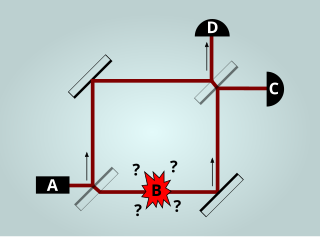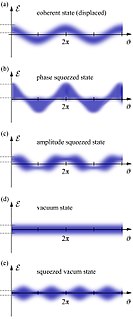
The many-worlds interpretation (MWI) is an interpretation of quantum mechanics that asserts that the universal wavefunction is objectively real, and that there is no wave function collapse. This implies that all possible outcomes of quantum measurements are physically realized in some "world" or universe. In contrast to some other interpretations, such as the Copenhagen interpretation, the evolution of reality as a whole in MWI is rigidly deterministic. Many-worlds is also called the relative state formulation or the Everett interpretation, after physicist Hugh Everett, who first proposed it in 1957. Bryce DeWitt popularized the formulation and named it many-worlds in the 1970s.

In quantum mechanics, Schrödinger's cat is a thought experiment that illustrates a paradox of quantum superposition. In the thought experiment, a hypothetical cat may be considered simultaneously both alive and dead as a result of its fate being linked to a random subatomic event that may or may not occur.
Wave–particle duality is the concept in quantum mechanics that every particle or quantum entity may be described as either a particle or a wave. It expresses the inability of the classical concepts "particle" or "wave" to fully describe the behaviour of quantum-scale objects. As Albert Einstein wrote:
It seems as though we must use sometimes the one theory and sometimes the other, while at times we may use either. We are faced with a new kind of difficulty. We have two contradictory pictures of reality; separately neither of them fully explains the phenomena of light, but together they do.

Quantum decoherence is the loss of quantum coherence. In quantum mechanics, particles such as electrons are described by a wave function, a mathematical representation of the quantum state of a system; a probabilistic interpretation of the wave function is used to explain various quantum effects. As long as there exists a definite phase relation between different states, the system is said to be coherent. A definite phase relationship is necessary to perform quantum computing on quantum information encoded in quantum states. Coherence is preserved under the laws of quantum physics.

Orchestrated objective reduction is a theory which postulates that consciousness originates at the quantum level inside neurons, rather than the conventional view that it is a product of connections between neurons. The mechanism is held to be a quantum process called objective reduction that is orchestrated by cellular structures called microtubules. It is proposed that the theory may answer the hard problem of consciousness and provide a mechanism for free will. The hypothesis was first put forward in the early 1990s by Nobel laureate for physics, Roger Penrose, and anaesthesiologist and psychologist Stuart Hameroff. The hypothesis combines approaches from molecular biology, neuroscience, pharmacology, philosophy, quantum information theory, and quantum gravity.
In quantum mechanics, the measurement problem is the problem of how, or whether, wave function collapse occurs. The inability to observe such a collapse directly has given rise to different interpretations of quantum mechanics and poses a key set of questions that each interpretation must answer.
Quantum Darwinism is a theory meant to explain the emergence of the classical world from the quantum world as due to a process of Darwinian natural selection induced by the environment interacting with the quantum system; where the many possible quantum states are selected against in favor of a stable pointer state. It was proposed in 2003 by Wojciech Zurek and a group of collaborators including Ollivier, Poulin, Paz and Blume-Kohout. The development of the theory is due to the integration of a number of Zurek's research topics pursued over the course of twenty-five years including: pointer states, einselection and decoherence.
The Schrödinger–Newton equation, sometimes referred to as the Newton–Schrödinger or Schrödinger–Poisson equation, is a nonlinear modification of the Schrödinger equation with a Newtonian gravitational potential, where the gravitational potential emerges from the treatment of the wave function as a mass density, including a term that represents interaction of a particle with its own gravitational field. The inclusion of a self-interaction term represents a fundamental alteration of quantum mechanics. It can be written either as a single integro-differential equation or as a coupled system of a Schrödinger and a Poisson equation. In the latter case it is also referred to in the plural form.

The Elitzur–Vaidman bomb-tester is a quantum mechanics thought experiment that uses interaction-free measurements to verify that a bomb is functional without having to detonate it. It was conceived in 1993 by Avshalom Elitzur and Lev Vaidman. Since their publication, real-world experiments have confirmed that their theoretical method works as predicted.

Wheeler's delayed-choice experiment is actually several thought experiments in quantum physics, proposed by John Archibald Wheeler, with the most prominent among them appearing in 1978 and 1984. These experiments are attempts to decide whether light somehow "senses" the experimental apparatus in the double-slit experiment it will travel through and adjusts its behavior to fit by assuming the appropriate determinate state for it, or whether light remains in an indeterminate state, exhibiting both wave-like and particle-like behavior until measured.
The Penrose interpretation is a speculation by Roger Penrose about the relationship between quantum mechanics and general relativity. Penrose proposes that a quantum state remains in superposition until the difference of space-time curvature attains a significant level.

Shadows of the Mind: A Search for the Missing Science of Consciousness is a 1994 book by mathematical physicist Roger Penrose that serves as a followup to his 1989 book The Emperor's New Mind: Concerning Computers, Minds and The Laws of Physics.
The quantum mind or quantum consciousness is a group of hypotheses proposing that classical mechanics cannot explain consciousness. It posits that quantum-mechanical phenomena, such as entanglement and superposition, may play an important part in the brain's function and could explain consciousness.
Objective-collapse theories, also known as models of spontaneous wave function collapse or dynamical reduction models, are proposed solutions to the measurement problem in quantum mechanics. As with other theories called interpretations of quantum mechanics, they are possible explanations of why and how quantum measurements always give definite outcomes, not a superposition of them as predicted by the Schrödinger equation, and more generally how the classical world emerges from quantum theory. The fundamental idea is that the unitary evolution of the wave function describing the state of a quantum system is approximate. It works well for microscopic systems, but progressively loses its validity when the mass / complexity of the system increases.
In quantum mechanics, the cat state, named after Schrödinger's cat, is a quantum state composed of two diametrically opposed conditions at the same time, such as the possibilities that a cat is alive and dead at the same time.
Counterfactual quantum computation is a method of inferring the result of a computation without actually running a quantum computer otherwise capable of actively performing that computation.

Cavity optomechanics is a branch of physics which focuses on the interaction between light and mechanical objects on low-energy scales. It is a cross field of optics, quantum optics, solid-state physics and materials science. The motivation for research on cavity optomechanics comes from fundamental effects of quantum theory and gravity, as well as technological applications.

In quantum physics, light is in a squeezed state if its electric field strength Ԑ for some phases has a quantum uncertainty smaller than that of a coherent state. The term squeezing thus refers to a reduced quantum uncertainty. To obey Heisenberg's uncertainty relation, a squeezed state must also have phases at which the electric field uncertainty is anti-squeezed, i.e. larger than that of a coherent state. Since 2019, the gravitational-wave observatories LIGO and Virgo employ squeezed laser light, which has significantly increased the rate of observed gravitational-wave events.
The Diósi–Penrose model was introduced as a possible solution to the measurement problem, where the wave function collapse is related to gravity. The model was first suggested by Lajos Diósi when studying how possible gravitational fluctuations may affect the dynamics of quantum systems. Later, following a different line of reasoning, R. Penrose arrived at an estimation for the collapse time of a superposition due to gravitational effects, which is the same as that found by Diósi, hence the name Diósi–Penrose model. However, it should be pointed out that while Diósi gave a precise dynamical equation for the collapse, Penrose took a more conservative approach, estimating only the collapse time of a superposition.
Gravitational decoherence is a term for hypothetical mechanisms by which gravitation can act on quantum mechanical systems to produce decoherence. Advocates of gravitational decoherence include Frigyes Károlyházy, Roger Penrose and Lajos Diósi.









